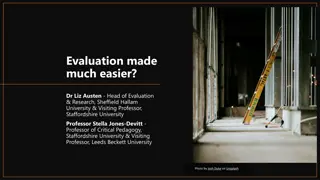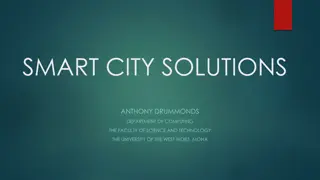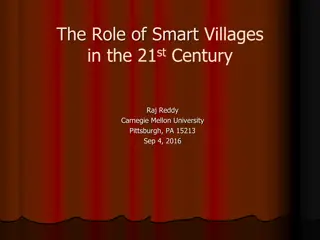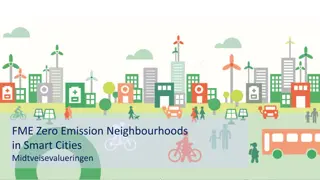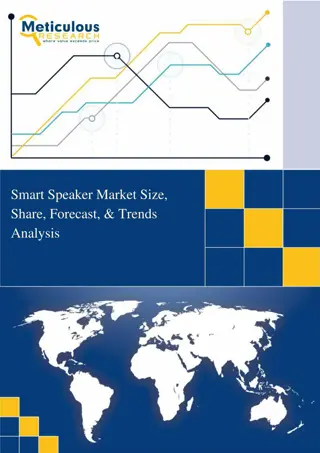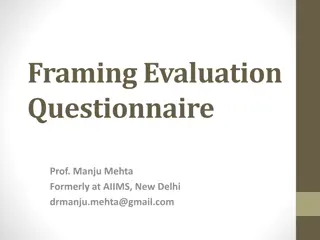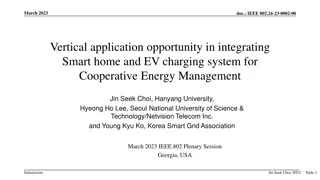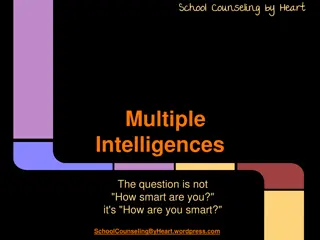Innovations in AM-Smart Methods for Policy Evaluation
Advances in integrating smart technology with interdisciplinary methods have led to the development of AM-Smart platforms, offering unique solutions for applied and public sector analysts. However, critical reflection reveals unevenness in design features, calling for a rigorous research agenda. The presentation aims to introduce this emerging field, explore critical engagement, and develop new smart methods for social science and health research.
Download Presentation

Please find below an Image/Link to download the presentation.
The content on the website is provided AS IS for your information and personal use only. It may not be sold, licensed, or shared on other websites without obtaining consent from the author.If you encounter any issues during the download, it is possible that the publisher has removed the file from their server.
You are allowed to download the files provided on this website for personal or commercial use, subject to the condition that they are used lawfully. All files are the property of their respective owners.
The content on the website is provided AS IS for your information and personal use only. It may not be sold, licensed, or shared on other websites without obtaining consent from the author.
E N D
Presentation Transcript
S M A R T M E T H O D S F O R C O M P L E X P O L I C Y E V A L U A T I O N Brian Castellani, PhD. FAcSS Professor of Sociology Director, Durham Research Methods Centre Co-Director, Wolfson Research Institute for Health & Wellbeing Durham University, UK
Advances in the integration of smart technology with interdisciplinary methods has created a new genre, approachable modelling and smart methods AM-Smart for short. AM-Smart platforms address a major challenge for applied and public sector analysts, educators and those trained in traditional methods: accessing the latest advances in interdisciplinary (particularly computational) methods. AM-Smart platforms do so through nine design features. They are (1) bespoke tools that (2) involve a single or small network of interrelated (mostly computational) methods (3) they also embed distributed expertise (4) scaffold methods use (5) provide rapid and formative feedback (6) leverage visual reasoning (7) enable productive failure (8) promote user-driven inquiry (9) while counting as rigorous and reliable tools
Critical reflection on AM-Smart platforms, however, reveals considerable unevenness in these design features, which hamper their effectiveness. A rigorous research agenda is vital. PURPOSE OF PRESENTATION This session will BRIEFLY introduce this newly emerging field, provide some examples, and then explore with attendees how to critically engage and develop new smart methods for social science and health research. The goal is to Examine the utility of this field Identify key concerns Sketch out ideas for possible AM-Smart methods Explore possible collaborations or venues for future research
A C K N O W L E D G E M E N T Corey Schimpf
CATALOGING AM-Smart Methods Given the fast-changing, endemic nature of smart app life today, it is presently difficult to bracket, count, or create a definitive catalogue of the AM-Smart methods currently in play. Examples range from computational modelling suites and statistical apps to digital research environments and smart phone apps to public- sector data management platforms and visualisation tools, such as those that flourished during the COVID pandemic
CATALOGING AM-Smart Methods To gain a basic impression of the field, we did the following. First, we reviewed the gallery of apps on R Shiny.2 Shiny is an R package that makes it easy to build interactive web apps straight from R. Given its open-source flexibility, a significant number of AM-Smart apps are made using R. Second, we did a Google search, using such terms as computational modelling and app and shiny and machine learning, which yielded most platforms we found. Third, we searched for AM-Smart platforms on the Apple App Store, which were primarily statistical or data management in nature. Finally, we put out a call on Twitter asking colleagues for examples, to which we received a handful of replies.
CATALOGING AM-Smart Methods Two caveats are important to note from our basic review. First, the majority of AM-Smart platforms are in the natural, engineering and computational sciences and applied mathematics. Second, we could not find a rigorous AM-Smart platform for qualitative inquiry. The closest we found were some of the R COMPASSS packages for running qualitative comparative analyses. But these were rather conventional. The development of qualitative AM-Smart methods could be a major avenue for anyone here today to pursue.
CATALOGING AM-Smart Methods Based on our initial survey, we identified a handful of best example platforms for social inquiry and, along with them, the nine key design features we listed earlier. COMPLEX-IT for computational modelling and data visualization Radiant for statistics and machine learning JASP for Bayesian statistical modelling PRSM for participatory systems mapping SAGEMODELER for learning systems dynamics through designing models MAIA NetLogo for designing and exploring agent-based models Cytoscape for modelling complex networks ExPanD for visually exploring your data. All these platforms are online and include tutorials, datasets, and published examples to explore
H I S T O R I C A L B A C K G R O U N D AM-Smart methods are part of the wider shift in the knowledge economy, particularly in the last two decades, toward smart technology. Smart technology builds on, extends, and adds to advances in smart environments, ubiquitous computing, smart devices, and the internet of things. AM-Smart platforms draw more specifically from two interdisciplinary fields of study: the learning sciences and human-computer interaction.
H I S T O R I C A L B A C K G R O U N D LEARNING SCIENCES Support the development of the complex and adaptive skills and knowledge needed for the knowledge economy and smart globalised world in which we now live. Extensively studies how computational technologies may be leveraged to support learning
H I S T O R I C A L B A C K G R O U N D HUMAN-COMPUTER INTERACTION Interdisciplinary field focused on understanding, designing, and evaluating the interface between people and computational technologies. Extensively involved in the development of many types of software, including those dedicated to research methods Its integration with the learning sciences to support the development of methods software is less common.
W H Y A M - S M A R T M E T H O D S ? IN THE SOCIAL SCIENCES, THREE REASONS: Massive growth in computational methods. Big data and the datafication of everything. Complexity and wicked problems.
W H A T I S A N A M - S M A R T M E T H O D ? They employ the latest advances in nonconscious machine cognition to create a methods environment in which the method acts as an expert guide for social inquiry. They do this by design: by allowing users to cognitively offload the challenges of running otherwise complex methods, they increase non- expert access to highly novel forms of methods-driven inquiry. Expertise is built into the smart technology of the platform.
C O R E C H A R A C T E R I S T I C S Features 1 and 2: Bespoke methods AM-Smart platforms are not like statistical packages such as SPSS or wide- breadth platforms such as MATLAB. AM-Smart platforms are bespoke tools that increase access and approachability by focusing on a single method or small network of closely interrelated methods.
C O R E C H A R A C T E R I S T I C S Feature 3: Building distributed expertise systems Most computational methods require a high level of user expertise. AM-Smart platforms address this issue by building expertise into the software, allowing the platform to become part of the user s distributed cognition system, primarily by acting as a skilled guide for social inquiry
C O R E C H A R A C T E R I S T I C S Feature 4: Scaffolding practice AM-Smart platforms are designed to increase effective usage of new methods. To do so, AM-Smart methods employ guides or supports, referred to as scaffolding in the learning sciences. Scaffolding involves a more knowledgeable entity (e.g. teacher, peers, or a tool) supporting a novice or new user to engage in practices or processes they may not otherwise be able to perform. The first type of scaffolding which overlaps with Embedding Expertise minimizes or removes low-level, tedious, routine, or overly complicated tasks. The second type is procedural scaffolding, which guides users through the operational aspects of a platform.
C O R E C H A R A C T E R I S T I C S Feature 5: Rapid and formative feedback AM-Smart platforms employ learning science strategies to provide rapid feedback that facilitates user understanding what scholars call formative, as opposed to summative, feedback
C O R E C H A R A C T E R I S T I C S Feature 6: Leveraging visual reasoning People often excel at processing and analysing visual information over other information formats. In our present data saturated world, visualisation has become a core area of methods study, contributing to several fields including data visualization, software design, visual complexity, and data science. Computational methods are intentionally visual in output from fractals and complex network diagrams to systems maps and agent-based model simulations. Visualizations tap strongly into distributed cognition.
C O R E C H A R A C T E R I S T I C S Feature 7: Enabling productive failure Within a research methods platform, failure could entail incorrectly specifying method parameters, selecting inappropriate factor types (e.g. categorical versus numerical), executing method-steps out of order, or misinterpreting results. While it may be tempting to scaffold these possible missteps, over-scaffolding can create an inauthentic and unrepresentative interaction with a method, where users are able to execute a method but not really learn how to use it correctly. AM-Smart platforms balance scaffolding with productive failure. Users can run a method-step with limited guidance, for example, and receive formative feedback if the results are outside typical ranges or expectations. By striking a balance, users recognize gaps in their knowledge of a method and begin to develop their mental model of it
C O R E C H A R A C T E R I S T I C S Feature 8: Supports user-driven learning and inquiry While multiple models for guiding learning through scientific inquiry exist, synthesized them into a meta-model involving five stages. They are orientation, conceptualization, investigation, conclusions, and discussion.
C O R E C H A R A C T E R I S T I C S Feature 9: Rigorous, authentic, and reliable method platforms Whenever a method is simplified for non-expert usage, there is the immediate tension around issues of rigor and reliability. While useful, is the platform dependable? While informative, are its algorithms accurate? While its results lead to new insights, can they be published or shared with others? And, while it facilitates learning, can the platform actually be used to guide decision making? AM-Smart platforms actively embrace this tension, seeking to support accessibility with highly rigorous programming. Case in point are the R packages and programming out of which many AM-Smart methods are built. Still, given the field is just emerging, unevenness does exist, making it critical that any AM-Smart app be vetted and field tested by experts in those methods.
C O R E C H A R A C T E R I S T I C S Feature 9: Rigorous, authentic, and reliable method platforms The other issue is task authenticity, which is particularly important to applied researchers and public sector analysts. Task authenticity refers to the degree to which a learning environment is sufficient complex to effectively model the real-world problem being studied
EXAMPLES brian.c.castellani@durham.ac.uk How do AM-Smart methods impact learning due to the speed at which we they work? The value or ramifications of datasets that have not been understood? The value of pausing and slow science. When is it good to have slow versus fast science? In terms of scaffolding how do we make sure of not cutting corners. How do we decide what to use based on different context and users and different levels of expertise. The importance of co-production. How could AM-Smart methods Throwing the baby out with the bathwater by critiquing conventional methods without being as critical of AM-Smart method. Are they actually learning what we want them to learn? Where is the learning taking place or not taking place? Are we smart enough for AM-Smart methods? The value of gaming environments for AM-Smart environments? This tends to favour fast processing.







